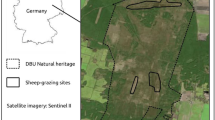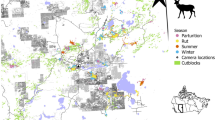Abstract
We recorded 30 24-h monitoring periods with 10-min sampling intervals on seven (three female; four male) Global-Positioning-System-collared adult free-ranging red deer (Cervus elaphus), from June 1999 to December 2000, in the Parc National des Cévennes, France. We observed the duration of resting bouts (n = 385) and then microhabitat variables (aspect, slope, presence of edge and litter, visibility, abundance of vegetation consumed or not) at 178 resting places. Resting bouts were shorter during the night than during the day from June to October but did not vary between sexes. Resting place visibility was lower during the day, especially in August. Daytime resting places generally offered more litter. Females used steeper slopes than males. We found higher variability in visibility and slope during the night. Aspect used did not vary from month to month or between day and night. Observed differences between day and night resting place characteristics suggest that red deer were probably facing a tradeoff between feeding and cover. Use of cover prevailed during the daytime whereas night resting place characteristics were more variable, indicating less constrained behaviour. Thus, cover (as a protection from disturbance), as well as food, is an important factor in red deer habitat use (at least during the day in disturbed areas) and should not be neglected in forest carrying capacity management.


Similar content being viewed by others
References
Adrados C (2002) Occupation de l’espace et utilisation de l’habitat par le Cerf (Cervus elaphus) en forêt tempérée de moyenne montagne—Approche au moyen du GPS. Ph.D. thesis, Université Paul Sabatier, Toulouse
Adrados C, Girard I, Gendner J-P, Janeau G (2002) GPS location accuracy improvement due to Selective Availability removal. CR Biol 325:1–6
Adrados C, Verheyden-Tixier H, Cargnelutti B, Pépin D, Janeau G (2003) GPS approach to study fine-scale site use by wild red deer during active and inactive behaviors. Wildl Soc B 31:544–552
Alldredge AW, Deblinger RD, Peterson J (1991) Birth and fawn bed site selection by pronghorns in a sagebrush-steppe community. J Wildl Manage 55:222–227
Aulak W, Babinska-Werka J (1990) Preference of different habitats and age classes of forest by roe deer. Acta Theriol 35:289–298
Baltzinger C (2003) Sélection des sites de repos par le Cerf (Cervus elaphus L.) et le Chevreuil (Capreolus capreolus L.) vivant en sympatrie en forêt tempérée de moyenne montagne. Ph.D. Thesis, ENGREF, Paris
Beier P, McCullough DR (1990) Factors influencing white-tailed deer activity patterns and habitat use. Wildl Monogr 109:1–51
CEMAGREF (1981) L’alimentation du Cerf élaphe. Synthèse des inventaires de gagnage effectués de 1974 à 1980 par la méthode d’Aldous: application à la détermination de la capacité alimentaire et territoriale, Etude n°10. Groupement Technique Forestier, CEMAGREF, Nogent-sur-Vernisson
Chen H, Li F, Luo L, Wang H, Ma J, Li F (1999) Winter bed-site selection by red deer Cervus elaphus xanthopygus and roe deer Capreolus capreolus bedfordi in forests of northeastern China. Acta Theriol 44:195–206
Clutton-Brock TH, Albon SD, Guinness FE (1982) Red deer: behaviour and ecology of two sexes. University Chicago Press, Chicago
Collins WB, Urness PJ (1981) Habitat preference of mule deer as rated by pellet-group distributions. J Wildl Manage 45:962–972
Coulombe M-L, Massé A, Côté SD (2006) Quantification and accuracy of activity data measured with VHF and GPS telemetry. Wildl Soc B 34:81–92
Craighead JJ, Craighead FC, Ruff RL, O’Gara BW (1973) Home ranges and activity patterns of non-migratory elk of the Madison Drainage Herd as determined by biotelemetry. Wildl Monogr 33:1–50
D’Eon RG (2001) Using snow-track surveys to determine deer winter distribution and habitat. Wildl Soc B 29:879–887
Daget P, Poissonnet J (1971) Une méthode d’analyse phytologique des prairies. Critères d’application. Ann Agron (Paris) 22:5–41
DePerno CS, Jenks JA, Griffin SL (2003) Multidimensional cover characteristics: is variation in habitat selection related to white-tailed deer sexual segregation? J Mammal 84:1316–1329
Dussault C, Courtois R, Ouellet J-P, Huot J (1999) Evaluation of GPS telemetry collar performance for habitat studies in the boreal forest. Wildl Soc B 27:965–972
Edge WD, Marcum CL (1989) Determining elk distribution with pellet-group and telemetry techniques. J Wildl Manage 53:621–624
Gebert C, Verheyden-Tixier H (2001) Variations of diet composition of Red deer (Cervus elaphus L.) in Europe. Mammal Rev 31:189–201
Georgii B, Schröder W (1983) Home range and activity patterns of male red deer (Cervus elaphus L.) in the alps. Oecologia 58:238–248
Germaine SS, Germaine HL, Boe SR (2004) Characteristics of mule deer day-bed and forage sites in current-condition and restoration-treated ponderosa pine forest. Wildl Soc B 32:554–564
Hofmann RR (1989) Evolutionary steps of ecophysiological adaptation and diversification of ruminants: a comparative view of their digestive system. Oecologia 78:443–457
Jeppesen JL (1987) Impact of human disturbance on home range, movements and activity of red deer (Cervus elaphus) in a Danish environment. Dan Rev Game Biol 13:1–37
Lakière V, Normant P, Ballon P (2001) Disponibilités alimentaires pour le Chevreuil (Capreolus capreolus) dans deux sapinières régulières et jardinées du second plateau du Jura. Rev For Fr 5:511–526
Lang BK, Gates JE (1985) Selection of sites for winter night beds by white-tailed deer in a Hemlock–Northern Hardwood Forest. Am Midl Nat 113:245–254
Linnel JDC, Nijhuis P, Teurlings I, Andersen R (1999) Selection of bed-site by roe deer Capreolus capreolus fawns in a boreal forest landscape. Wildl Biol 5:225–231
Lotek Engineering Inc. (1997) GPS collar user’s manual. Lotek Engineering Inc., Newmarket
Main MB, Weckerly FW, Bleich VC (1996) Sexual segregation in ungulates: new directions for research. J Mammal 77:449–461
Merrill EH (1991) Thermal constraints on use of cover types and activity time of elk. Appl Anim Behav Sci 29:251–267
Miquelle DG, Peek JM, Van Ballenberghe V (1992) Sexual segregation in Alaskan moose. Wildl Monogr 122:1–57
Millspaugh JJ, Raedeke KJ, Brundige GC, Willmott CC (1998) Summer bed sites of Elk (Cervus elaphus) in the Black Hills, South Dakota: considerations for thermal cover management. Am Midl Nat 139:133–140
Moen R, Pastor J, Cohen Y (1996) Interpreting behavior from activity counters in GPS collars on moose. Alces 32:101–108
Morellet N, Guibert B (1999) Spatial heterogeneity of winter forest resources used by deer. Forest Ecol Manag 123:11–20
Mysterud A (1996) Bed-site selection by adult roe deer Capreolus capreolus in southern Norway during summer. Wildl Biol 2:101–106
Mysterud A, Østbye E (1995) Bed-site selection by European roe deer (Capreolus capreolus) in southern Norway during winter. Can J Zool 73:924–932
Mysterud A, Østbye E (1999) Cover as a habitat element for temperate ungulates: effects on habitat selection and demography. Wildl Soc B 27:385–394
Normant P, Baltzinger C (2004) Les typologies de faciès alimentaires pour les cervidés: application à la forêt domaniale de Perseigne (Sarthe). Rendez-vous Techniques de l’ONF 6:50–56
Ockenfels RA, Brooks DE (1994) Summer diurnal bed sites of Coues white-tailed deer. J Wildl Manage 58:70–75
Ohmann JL, Spies TA (1998) Regional gradient analysis and spatial pattern of woody plant communities of Oregon forests. Ecol Monogr 68:151–182
Pépin D, Renaud PC, Dumont B, Decuq F (2006) Time budget and 24-h temporal rest–activity patterns of captive red deer hinds. Appl Anim Behav Sci 101:339–354
Sokal RR, Rohlf FJ (1981) Biometry. The principles and practice of statistics in biological research, 2nd ed. Freeman WH and Company, San Francisco
Staines BW (1974) A review of factors affecting deer dispersion and their relevance to management. Mammal Rev 4:79–91
Strohmeyer DC, Peek JM, Bowlin TR (1999) Wapiti bed sites in Idaho sagebrush steppe. Wildl Soc B 27:547–551
Wecker SC (1964) Habitat selection. Sci Am 195:3–10
Weckerly FW, Ricca MA (2000) Using presence of sign to measure habitats used by Roosevelt elk. Wildl Soc B 28:146–153
White GC, Garrot RA (1990) Analysis of wildlife radio-tracking data. Academic Press, San Diego
Zollner PA, Smith WP, Brennan LA (2000) Microhabitat characteristics of sites used by swamp rabbits. Wildl Soc B 28:1003–1011
Acknowledgments
We thank the Institut National de la Recherche Agronomique and Office National des Forêts for financial support and the Parc National des Cévennes for technical support. We thank J. M. Angibault, B. Cargnelutti, N. Cebe, J. Joachim and D. Picot for assistance in data collection. Vicky Moore kindly improved the English in an earlier version of the manuscript. Capture methods were approved by the French Ministry of Environment, and two authors of this paper (G. J. and D. P.) were entitled by the French Ministry of Agriculture to experiment on free-living mammals (certificates 7382 and 7060).
Author information
Authors and Affiliations
Corresponding author
Additional information
Communicated by W. Lutz
Rights and permissions
About this article
Cite this article
Adrados, C., Baltzinger, C., Janeau, G. et al. Red deer Cervus elaphus resting place characteristics obtained from differential GPS data in a forest habitat. Eur J Wildl Res 54, 487–494 (2008). https://doi.org/10.1007/s10344-008-0174-y
Received:
Revised:
Accepted:
Published:
Issue Date:
DOI: https://doi.org/10.1007/s10344-008-0174-y




